When it comes to choosing the right label for your jam jar, you can’t afford to get things wrong.
Whether you're an expert jam maker or you’re just getting started with a brand new candle business, choosing the right label size for your jars makes a big difference to how your product looks and feels.
Luckily, you’re not alone - we’re here to help. Below, we’ve taken a look at jar sizes, label types and measurement tips so your jar is guaranteed to stand out on any shelf.
Simplify Jar Label Creation With Our Size Guide
Though there’s a lot to think about when you’re creating a custom label for your jam jars, the process doesn’t have to be daunting. With so many jar shapes and sizes available, there’s something for everyone, from candlemakers to jam maker extraordinaires. But, it’s important to match your label to your jar size, as this creates the most professional finish.
Before you jump into jar label creation, think about the right label size for your chosen jar type and size, and decide which label style will boost your branding and appeal to your target market.
How Different Jar Sizes Can Be Used
As you might expect, one of the main uses of jars is to store and sell jam, but that’s not all. As jam jars are a versatile packaging solution, they can be used for a wide range of handmade and luxury goods. Whether you're making candles, bath salts or chutneys, or putting together wedding favours for friends and family, choosing the right jar size is key.
When you get the size of the jar right, you can confidently showcase what’s inside. Here are some of the most popular jam jar sizes and what they’re commonly used for:
Mini Jars - These are perfect for samples, wedding favours or toiletries, such as those you might find in a hotel. These mini jars are often used for tester candles, mini honey pots or condiments, or luxury bath salts in gift sets.
Small Jars - Holding between 180ml to 200ml, small jam jars are ideal for homemade chutneys, spice mixes, small candles and sweets. They also work well for skincare, tester cosmetics, herbs, spices and seasonings.
Standard Jars - These are the standard jam jars that you’re used to seeing on supermarket shelves, and they’re commonly used for small batches of jam, marmalade, relish, gifting preserves or sauces. Plus, as they can hold between 350ml and 380ml, they’re also a great middle ground for chutneys, pickles or curds, as well as homemade candles.
Large Jars - Whether you’re packaging luxury candles, pickled vegetables, oils, loose tea or craft supplies, large jars are an excellent choice. They hold between 800ml and 1000ml, striking a balance between product protection and size.
Oversized Jars - Though they’re less commonly used, oversized jars are ideal for bulk gifting, storage and centerpieces. They’re also used for things like large batches of bath salts, granola, non-perishable food storage and multi-wick candles.
Recommended Jar Label Sizes
Choosing the right label size for your jar is key to achieving a clean and professional look. To help you get started, this guide provides our recommended label dimensions for a variety of popular jar sizes.
Rectangle Jar Labels
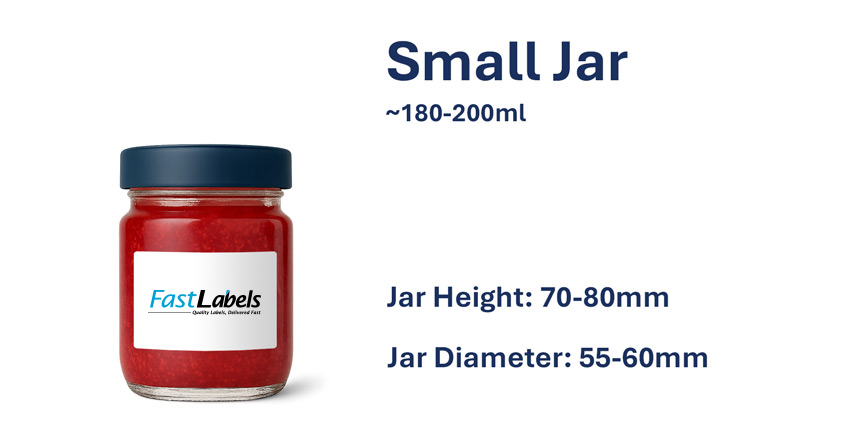
|
Landscape Label: 50 x 45 mm
Portrait Label: 45 x 50 mm
Wraparound Label: 50 x 172 - 188 mm
|
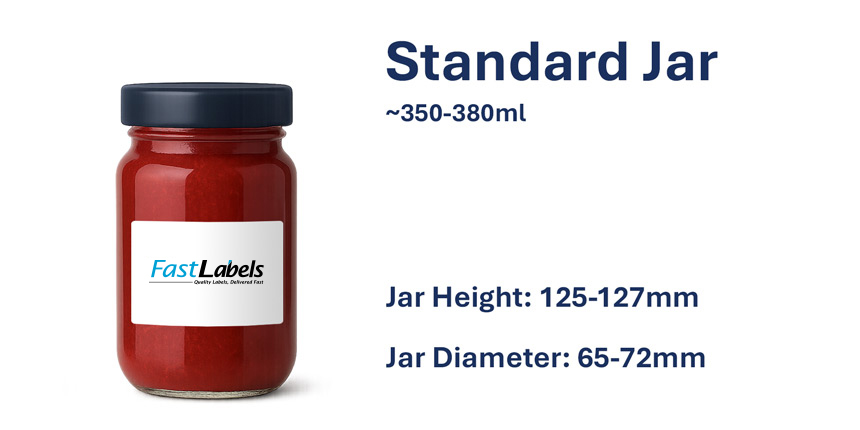
|
Landscape Label: 55 x 50 mm
Portrait Label: 50 x 55 mm
Wraparound Label: 55 x 202 - 224 mm
|
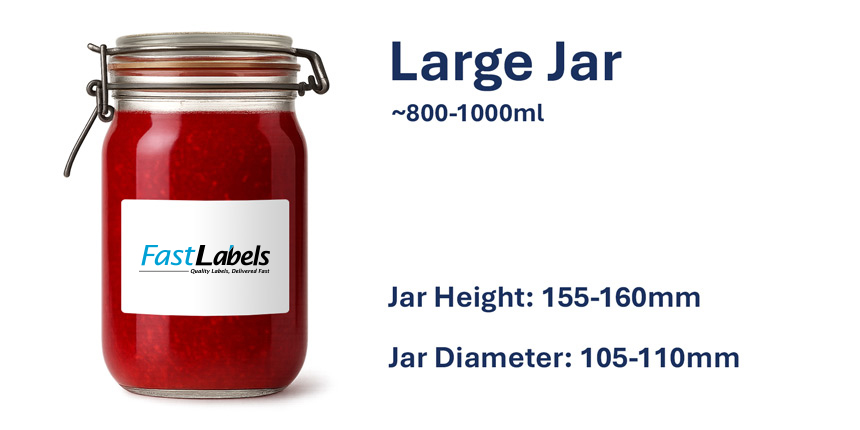
|
Landscape Label: 90 x 70 mm
Portrait Label: 70 x 75 mm
Wraparound Label: 90 x 337 - 338 mm
|
Wraparound label sizes assume there’s no overlap. You can adjust the width slightly if you prefer an overlapping edge, or if you want more spacing between label ends.
Square Jar Labels
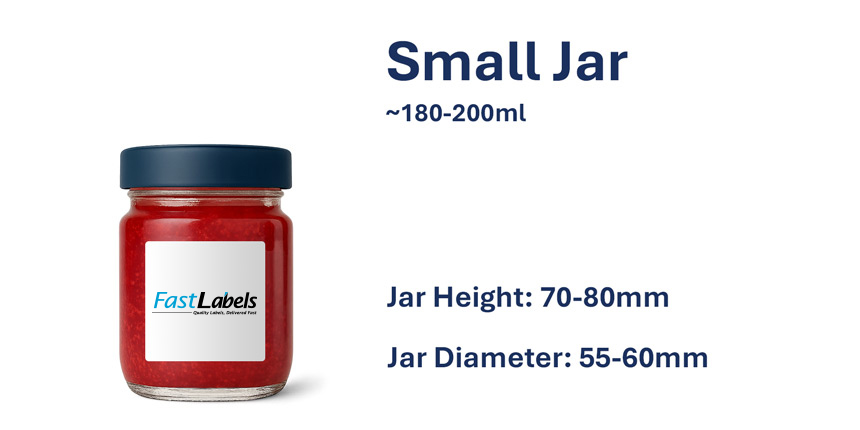
|
Recommended Label Size:
35 x 35mm – 50 x 50mm
|
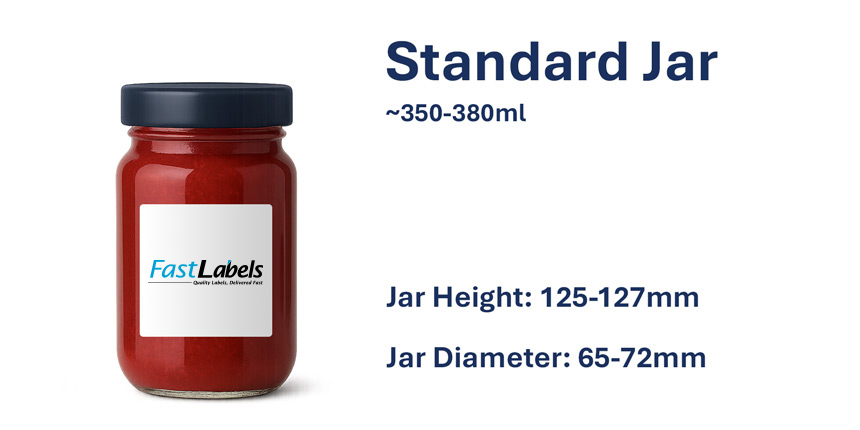
|
Recommended Label Size:
40 x 40mm - 55 x 55mm
|
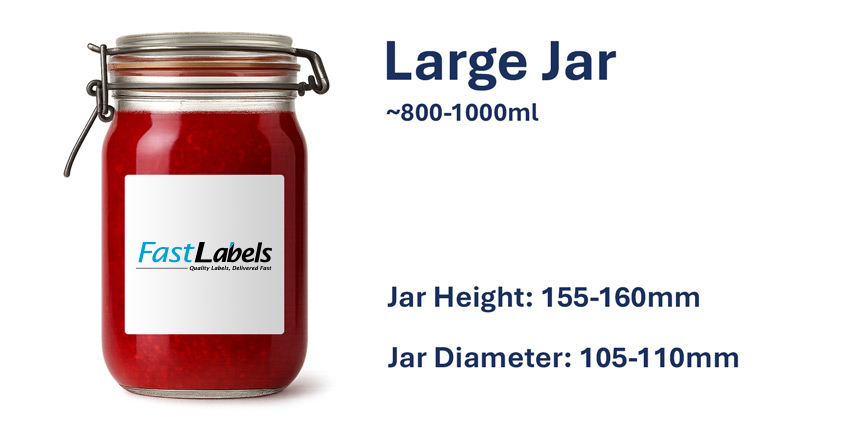
|
Recommended Label Size:
60 x 60mm - 90 x 90mm
|
Round Jar Labels
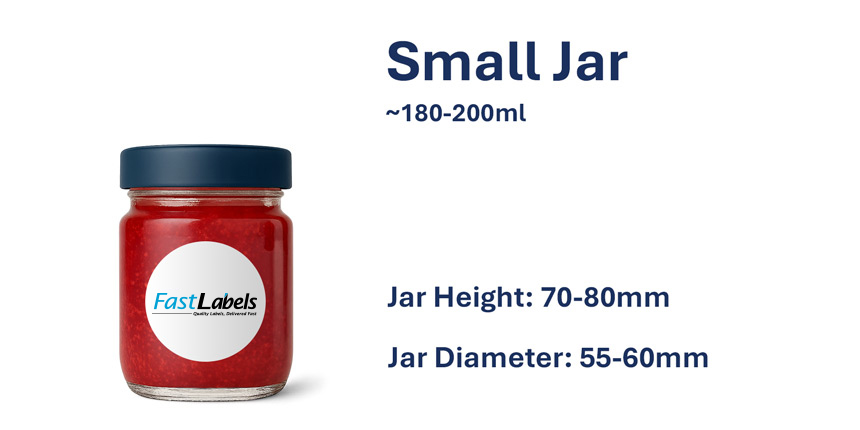
|
Recommended Label Size:
35 x 35mm – 50 x 50mm
|

|
Recommended Label Size:
40 x 40mm - 55 x 55mm
|
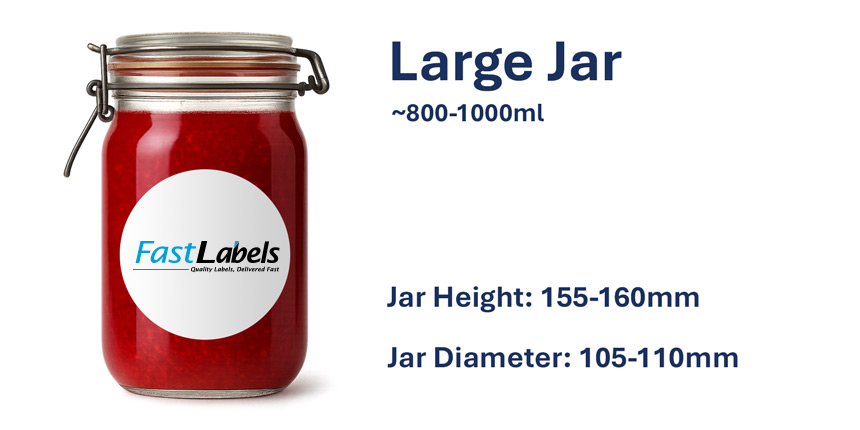
|
Recommended Label Size:
60 x 60mm - 90 x 90mm
|
Jar Lid Labels
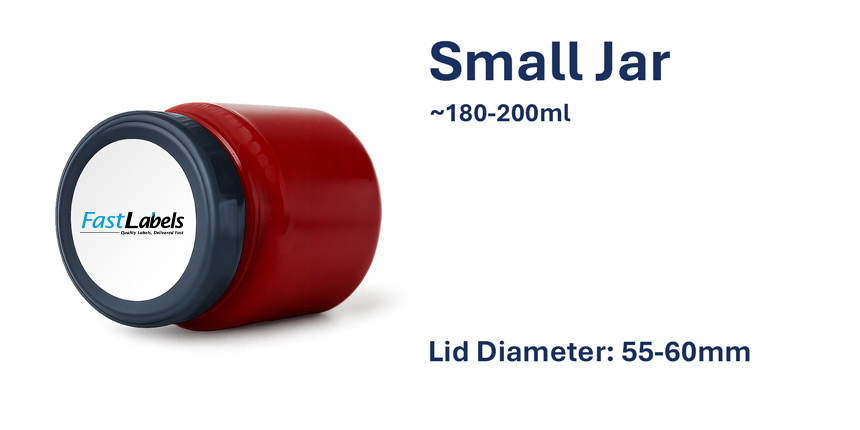
|
Recommended Label Size:
30 x 30mm - 37 x 37mm
|
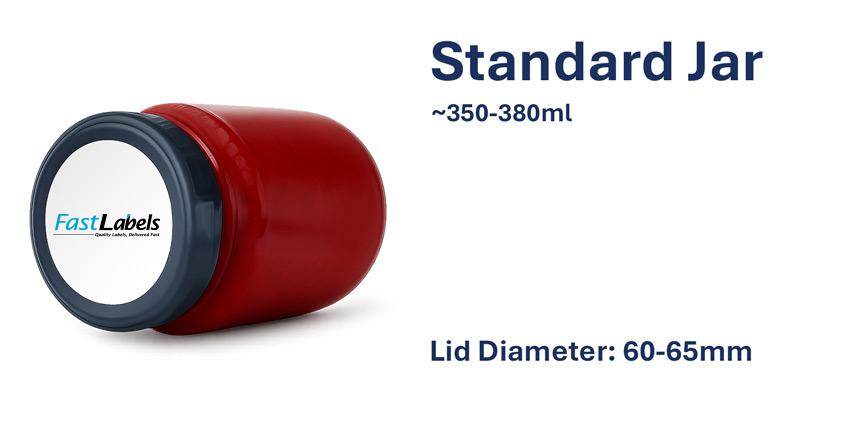
|
Recommended Label Size:
40 x 40mm - 60 x 60mm
|
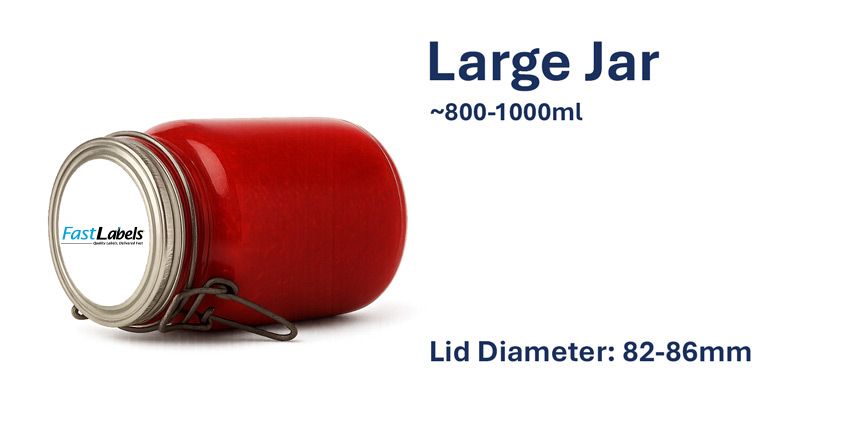
|
Recommended Label Size:
60 x 60mm - 70 x 70mm
|
Tamper Seal Labels
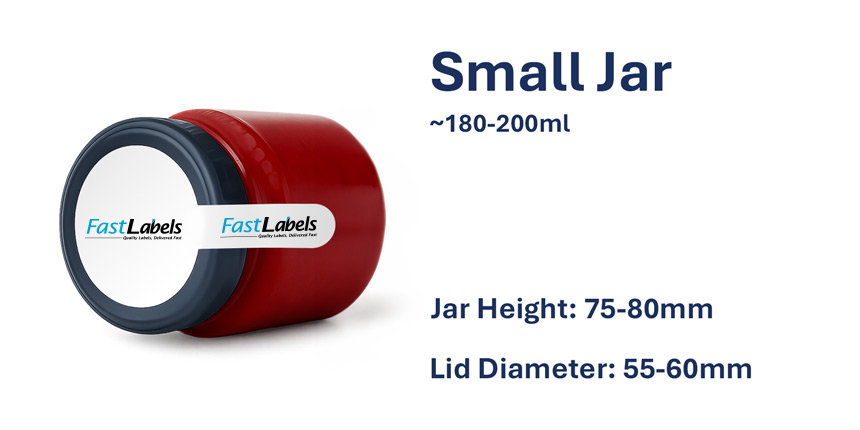
|
Recommended Round Label Size:
30 x 30mm - 37 x 37mm
Recommended Seal Length:
37mm - 40mm
|
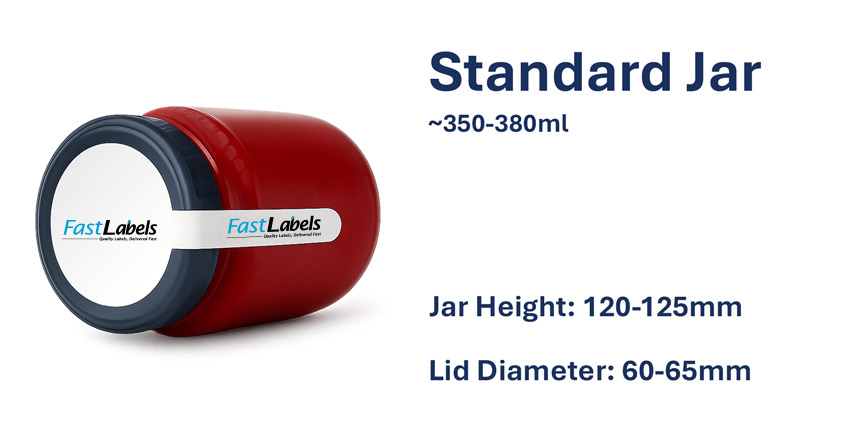
|
Recommended Round Label Size:
40 x 40mm - 60 x 60mm
Recommended Seal Length:
60mm - 62.5mm
|
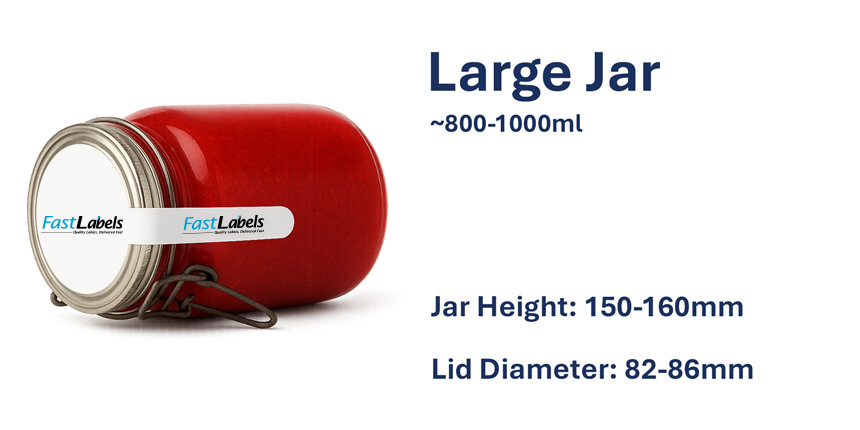
|
Recommended Round Label Size:
60 x 60mm - 70 x 70mm
Recommended Seal Length:
75mm - 80mm
|
Measurement Advice: Find the Ideal Jar Label Size
Whether you’re designing a front label, a wrap around label or a lid sticker, taking a few simple measurements will ensure your labels fits neatly and stays in place, with a professional finish.
Wrap Around Rectangle Labels
- Take a piece of string and wrap it once around the middle of your jar, where you want the label to go.
- Pinch the string where it meets the starting point, then lay it flat against a ruler to find the total circumference. This gives you the maximum width your label can be.
- To ensure a clean finish without overlap, reduce that measurement by a couple of millimetres. This leaves a neat little gap between the label ends when applied.
- For the height, measure the flattest part of the jar’s body, avoiding any curved areas at the top or bottom. This gives you a reliable height where the label can sit smoothly and securely.
Staying within the flat surface helps prevent bubbling or peeling, giving your product a more polished, professional appearance.
Square Labels
When applying a classic square label, the goal is to create a clean, balanced look with a bit of breathing room around the edges.
- Start by measuring the flat front surface of your jar - both the width and the height - up to where any curves or edges begin. You’ll likely get two different numbers.
- To find the ideal label size, use the smaller of those two measurements and subtract around 10mm.
- This gives you a well-proportioned square label that fits comfortably within the flat area, without getting too close to the edges.
For example, if your jar's front is 70mm wide and 80mm tall, you'd go with the smaller dimension or 70mm, subtract 10mm, and land on a 60mm x 60mm label. This method ensures your label sits neatly without curling or lifting.
Alternatively, you can simply decide how much space you'd like your label to cover, but be mindful of curved areas or corners that could cause the label to peel.
Circle Labels
For a circular label that looks perfectly placed and balanced, the key is to stay within the "safe zone" - the flat area of your jar’s surface - so the label doesn’t appear squashed or off-centre.
- Start by imagining the front of your jar as a rectangle.
- Measure the width of this flat space from left to right, and then the height from top to bottom, stopping before any part of the jar starts to curve.
- As a circle has equal width and height, your label’s size is limited by the shorter of those two measurements.
To ensure a clean, professional look, subtract around 8 - 10mm from the smaller number. This gives you the ideal diameter for your circle label, leaving enough margin around the edges so it doesn’t extend into any curved areas.
For example, if the flat area on your jar is 65mm wide and 75mm tall, use the shorter measurement of 65mm, subtract 10mm, and you’re left with a perfect 55mm diameter for your label.
Jar Lid Labels
To get a perfectly centred and professional looking lid label, the trick is to focus on the flat, central area of the lid, what is known as the "bullseye." If you look straight down at your jar lid, you’ll usually notice a smooth circular section in the middle, surrounded by a slightly raised rim. The flat inner circle is your ideal label space.
- Use a ruler to measure the diameter of this smooth area, going straight across from one edge to the other.
- Be sure to ignore the raised rim, as your label should sit entirely within the flat section for the best results.
- Once you have your measurement, subtract just 2mm. This tiny adjustment allows for easy application and ensures the label doesn’t catch or lift at the edges over time.
For example, if the flat area on your lid measures 55mm across, a 53mm diameter label will fit perfectly inside, giving you a snug and clean finish.
Tamper Seals Labels
- Start by choosing a label width - this is usually between 10mm and 30mm - depending on your design preference and how prominent you want the seal to appear.
- For the length, use a flexible tape measure to find the distance from your chosen anchor point on the side of the jar, up and over the centre of the lid, and down to the corresponding point on the opposite side.
- This full measurement ensures a well-fitted seal that wraps securely across the lid and both sides of the jar.
If you're using a single-ended seal that only sticks to one side, simply measure from that side up to the centre of the lid.
How to Choose the Right Label for Your Jar
A jar label is much more than a sticker, and it’s not just there for decoration. It’s the first thing a lot of people will see of your brand, and it needs to make a good first impression. Here are the most common types of labels used on jars:
- Front Labels - These are used in the main branding area, and they include your logo, product name and flavor.
- Back Labels - These are somewhat optional, but they’re useful for ingredients, nutritional info and barcodes.
- Jar Lid Labels - Ideal for displaying your logo, especially for top-down displays in gift boxes or baskets, where front and back labels may not be seen straight away.
- Tamper Seal Labels - Tamper seals add safety and professionalism to a jar. They can go from lid to jar side or wrap around the neck and down both sides, depending on your chosen design.
- Wrap Around Labels - These allow you to maximise the amount of branding on the jar, and give you a lot of space to add information. They’re great for storytelling, instructions, or decorative designs.
Ready to Order Your Jam Jar Labels?
Taking the time to measure your jars properly ensures your labels not only look great, but are also secure and professional. Whether you're packaging food, gifts or handmade candles, the right label size elevates your brand. Get in touch with our label sizing experts to find out more.